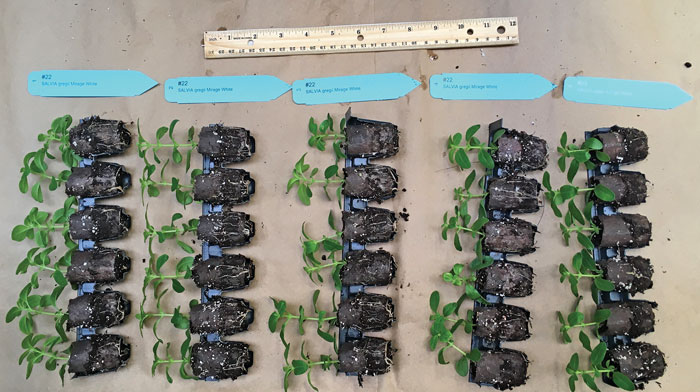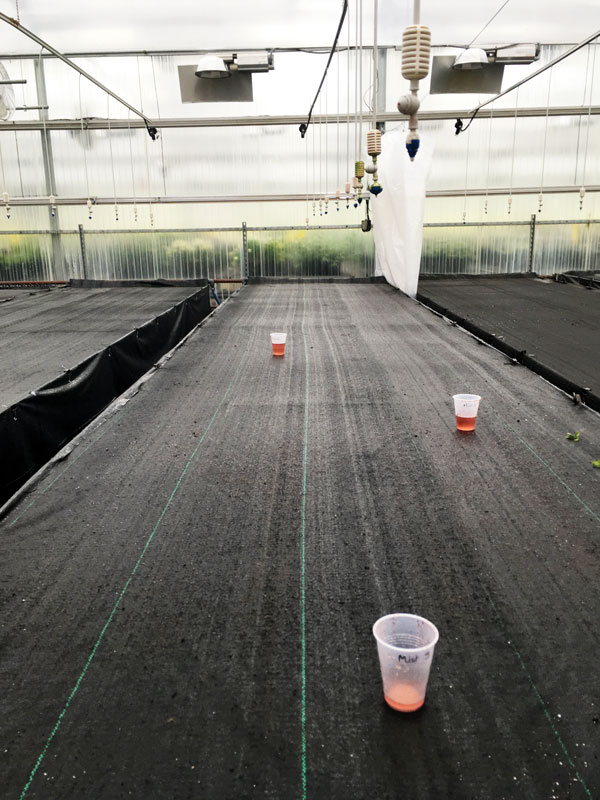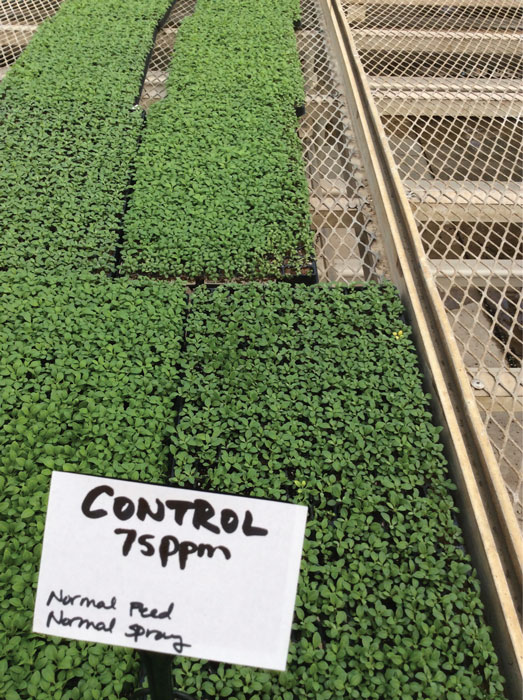5/1/2020
Optimizing Your Greenhouse Trial Program
Bill Calkins

There are many reasons you might want to conduct greenhouse trials. Maybe you want to test new varieties that could be added to your portfolio. Perhaps you’re testing new production methods or greenhouse systems. Sometimes changing chemical regimes, introducing biologicals or reducing PGRs is the goal. No matter what changes you’re looking to make, it’s beneficial to conduct trials.
Pictured: When trialing different treatments, line up examples after the trial to see results more clearly.
Jason Twaddell, National Sales and Marketing Manager for Ball FloraPlant, spent 13 years in greenhouse production for three different growers producing spring bedding and seasonal crops before moving into technical support and now sales leadership, and has grown and overseen hundreds of greenhouse trials. He feels trialing is a strategy best used to solve problems like crop quality, stagnant sales numbers and an aging product list.
“You should trial to improve your company’s product quality,” he said. “You should also trial to increase profitability and to stay up to date on the latest and greatest products.”
With margins getting narrower and the industry’s tolerance for inefficiency and shrink dropping to near zero, trialing and testing seems more important now than ever. Jason feels growers are getting better at trialing in the past few years, but it’s still something that needs more emphasis.

Where to begin
There’s always room to improve any crop. Jason uses the analogy that greenhouse production is like manufacturing any product.
“You should always be working on incremental improvements,” he explained. “It’s a crawl, walk, run approach.” You should always think: What can I improve? This can range from processes to chemical use or variety selection.
Pictured: Measuring irrigation output throughout your greenhouse is a good trial to learn about differences impacting crops.
When trialing to improve labor efficiency, Jason suggested beginning with your most labor-intensive processes.
“Your sticking line might be a place to start,” he said. “With so much labor and complexity involved, many growers are trialing new processes and automation equipment. Efficiency will go right to the bottom line.”
To explore new genetics for better habits or colors, start with your poorest performers. For incremental gains in your propagation processes, identify problem varieties and begin rooting trials.
Jason said in his previous life as a propagator, he conducted a lot of rooting hormone trials to speed up the process and boost profitability, without sacrificing quality.
“Our goal was to get crops off mist as fast as possible,” he said. “We looked at rates, timing and the type of application.”
Another type of trial he conducted in the past determined when he could get away with a no-pinch approach. If so, labor costs were reduced, sanitation risks were minimized and profits went up, but the only way to know for sure was to trial.
A Kaizen approach
Jason cites the Continuous Improvement strategy, which is a lean-flow tactic that helps any workplace maintain focus on improving the way things are done on a regular basis. Sometimes this is all about incremental improvements, while other times it helps achieve bigger goals. Both are very relevant in any greenhouse operation.
Basically, Continuous Improvement follows a path of Plan—Test—Check—Act. When planning, your team looks at the current processes, brainstorms ideas for improvement, decides how these ideas might be implemented, creates objectives and outlines the plan of action. The test phase is just that—implement the plan. This could require a change in process, which often means new training and adding in controls to avoid problems.
 Pictured: Grouping and labeling plants for analysis after your trial will help determine results.
Pictured: Grouping and labeling plants for analysis after your trial will help determine results.
Then comes check, which is a lot like collecting data, measuring and analyzing. Be sure to spend time during this phase adding corrective or preventative actions to help achieve the results you want. Last, comes the act step. Once all of the data is analyzed, you and the management team must determine whether the trial activity should become permanent. After the change is in place, it’s time to begin planning again because your business should never be still. There are always more improvements to be made.
Jason brought this back to the greenhouse level and trialing. “Identify where opportunities are for improvement, create a plan and how to analyze the best treatment or method based on the results, execute the plan using your new process and then review your trial,” he said.
Execution is key
When planning a greenhouse trial—whether related to new variety selection, labor processes, new chemicals or prevention strategies or any other pain point you want to eliminate—you need to make it a priority. All too often, big trial plans start off well, but eventually slip to the back burner when things get busy or new ideas take our eyes off the ball. When this happens, time and money are wasted, and who can afford that?
Jason recommended formally allocating resources to your key trials. “Treat trials as a major part of your production strategy,” he advised. “Assign a Trial Manager role and create a champion within your company.”
Make sure this person has the resources they need to successfully complete each trial and allow them to recruit others, to help drive buy-in.
And be sure to trial plants at the right time. “Timing is everything,” Jason said. “You have to carve out the space for trials, even when you’re busy.”
It’s hard to determine how a trial will do in spring production if you conduct the trial in fall, he explained.
Closing the case
Once your trials conclude, don’t just move on with a new process and never look back. Be sure to set aside time to review the entire trial from start to finish, because like any process, you can improve your approach next time. And whenever possible, use data to determine the success or failure of a trial.
Jason reminds growers conducting trials that data collection is only as good as the data coming in. “Use your smartphone to record photos or video of each trial,” he said. “Use technology to document every step.” Start your trials process small and grow as more data becomes available, he added.
Lessons from the field
Horticulture is a collaborative industry and there are always trials happening, resulting in opportunities for you to learn successful strategies. Universities conduct trials, testing just about every variable imaginable; breeders and crop protection manufacturers are constantly reading trials; trade media outlets like GrowerTalks publish trial results every month; and regional and grower trials abound. The folks involved in these trials are usually more than happy to discuss their research methods and can be a wealth of information to help you get started.
Don’t be afraid to ask for details. Most professional trials are well documented because results are published or used to assist in product development or sales. Similarly, your results will help inform production teams creating plans for the year or your sales team promoting new products. The more details collected and documented the better. The more examples you see, the better your trials will get.
Finally, as you make it a priority to go out and read local and regional trials, Jason feels your overall crop selection will improve. This leads to better performance for your customers and more opportunity to retain and grow that business. GT
For more, tune into Episode 24 of the STEM Greenhouse Podcast where Bill and Jason discuss “Creating Your Trialing Plan."